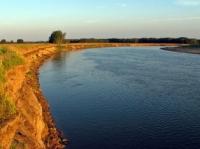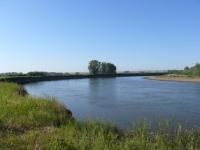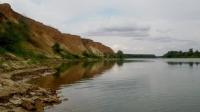Вы здесь
Ural River south of Uralsk.




Rafting on the Ural River in Kazakhstan.
“Here the river flows, languishing with a premonition of merging with the green waves of the Caspian”
Walks on the Ural River in Kazakhstan.
South of Uralsk, both banks of the Urals are surrounded by a semi-desert and desert plain with small depressions and saucers. The river valley stands out sharply against the general background of a dull Caspian landscape. Its characteristic feature is a wide (from 2 - 3 to 8 - 10 km) floodplain, bordered by narrow (1 - 3 km) strips of the lower floodplain terrace, which rises 8 - 11 m above the low-water level. Sometimes the higher second and third terraces come close to the river.
High water levels in spring and early summer, as well as a relatively fast flow, erode the banks, which collapse into the channel after the decline of water in huge blocks. As a result of this, the channel of the Urals is constantly changing, new sleeves are formed, drying out backwaters, old ladies, eriks.
By deposits of eroded rocks, the Ural is rebuilding its floodplain, more and more rising above the surrounding plain. Sometimes, after a high and stormy flood, the floodplain landscape appears to be reborn, the entire floodplain is covered with a layer of silt and sand, new ridges, channels, islands form. In places where the root coast is eroded, high cliffs form, which, due to the regular wandering of the river along the floodplain, alternate either along the right or left bank.
Extreme floodliness is characteristic of the entire floodplain, only closer to the mouth it becomes calmer. On the way to the Caspian, the Urals crosses its ancient deltas, which were formed at different stages of the retreat of the Khvalyn Sea and left their mark on the character of the modern valley of the Urals.
There are four stages of retreat of the Khvalynsk Sea. The first time the sea departed from the Presyrt ledge 80 - 90 km - formed Kushumek delta branching; the Kushum River, flowing from the Urals, has survived and developed from it.
For the second time, the sea retreated another 200 - 250 km, forming the Bagyrdai delta, located north of the village of Antonova. Here, the second largest outflow of the Urals, Bagyrdai, is now beginning. The third retreat pushed the sea to the Novobogatinsky delta system, which begins with the outflow of Baksai near the village of Dzholgaisay.
In addition to Baksai, the ancient arms of the Ural delta Ashisay, Sorochinka, the Black River on the right bank and the Sokolok on the left have survived. In 1957, the ducts of the Novobogatinsky system were last replenished with water and dumped their flow into the sea.
Later, many sleeves were blocked by dams. Pumping stations installed at the source of these hoses supply water for irrigating hayfields and watering livestock. For example, according to the Baksai system, Ural water is distributed along a channel far to the west almost to the mouth of the Volga.
The fourth retreat of the Caspian formed the modern Ural delta, south of Guryev. In spring, at a high flood level, part of the water rushes along the channels of the branches, extending from the Urals to the southwest. In summer, this connection is interrupted and most of the sleeves dry up.
The Ural floodplain in the lower reaches is divided into three parts: the riverbed, central and high. The near-river floodplain rises, usually above the low water by 1.5 –8 m, the central one by 3.5 – 8.5 m, and high by 6 – 10 m. The average flood level in the floodplain is 5 – 6 m; to the mouth it decreases to 1-3 m.
In 1942, the highest flood was observed near the village of Kalmykova. The level of the river rose by 11 m, hollow waters flooded the floodplain terrace and penetrated into the interfluvial spaces by lowerings. A distinctive feature of the river floodplain is a maned relief formed by coastal ramparts and channels.
Its width does not exceed 300 - 400 m, it is composed of loose sandy layered sediments, overlain in depressions by silty sediments. The forest of these groves is not rich and is represented by rare bushes. A hundred years ago, forest vegetation in the floodplain of the Urals was much richer.
Oak, for example, was found up to the latitude of Kalmykov (in fact, on the border of the desert and semi-desert). Now the southernmost floodplain oak forest is located 35 - 40 km northeast of Uralsk. Much to the south penetrated the birch.
According to G. S. Karelin, in the middle of the last century a hornbeam was encountered in the floodplain of the Urals. Nowadays this western species, extremely demanding on heat and moisture, does not grow anywhere west of the Donetsk Ridge.
First of all, the most valuable hardwoods - oak and birch - were destroyed by man. Therefore, it can be assumed that modern poplar forests of the Ural valley grow in place of mixed oak and birch forests. It becomes obvious that measures are now needed to preserve the last remains of woody vegetation at the border of their distribution - sections of the southernmost poplar forest in the north of the Atyrau region.
Authority:
A.A. Chibilev. "The Ural River." Leningrad. Hydrometeoizdat, 1987.
Photos
Alexander Petrov.







